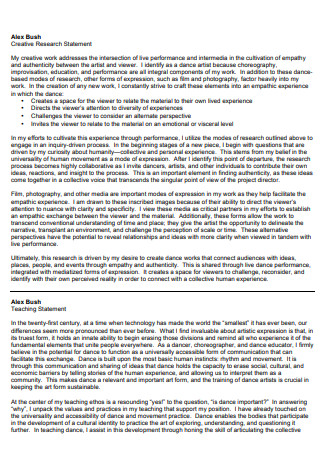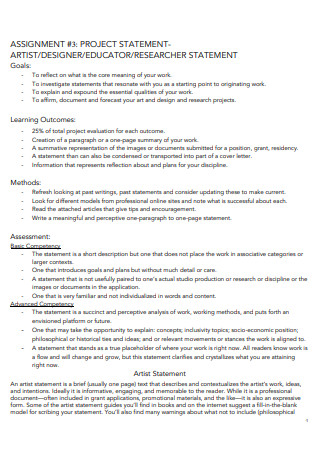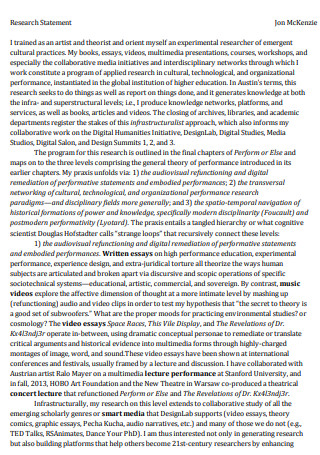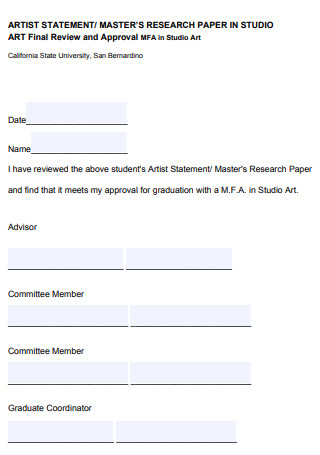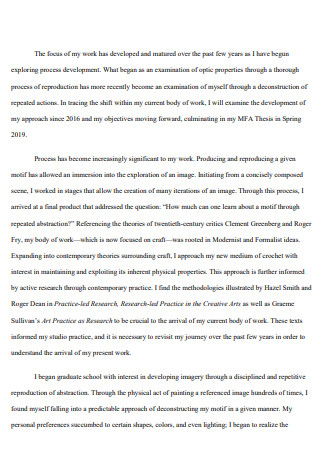5+ SAMPLE Artist Research Statement
FREE Artist Research Statement s to Download
5+ SAMPLE Artist Research Statement
What is an Artist Research Statement?
Different Methods of Artistic Research
Basic Components of an Artist Research Statement
How to Write an Artist Research Statement
FAQs
What is the purpose of artist research?
What are the fundamental elements of an artist research statement?
What are some examples of an artist research statement?
How is an artist considered as a researcher?
What is the difference between an artist research statement and an art research paper?
What is an Artist Research Statement?
An artist research statement is a simple yet distinct piece of professional writing which comprises the principal ideas or key points about a specific artist study of a graduate student or aspiring artist researcher, demonstrating the different scopes of the research in creative arts and humanities, especially in clarifying the elements of an artwork made by an artist. This is a beneficial document which will significantly help several artist researchers, creative professionals, and other art enthusiasts to share the significance and impact of their artistic research, particularly on how their artist research will lead to remarkable contributions to the arts and humanities field in the future.
According to several key national findings, the average annual growth rate for arts and culture surpasses the growth rate of the total U.S. economy. For example, the average annual growth rate in the contribution of arts and culture in 2014-2016 was 4.16%, nearly double the 2.22 percent growth rate of the total U.S. economy. Thus, it is very important for artist researchers to develop an effective artist research statement because of its essential contribution to the arts and design industry.
Different Methods of Artistic Research
The basic formula of artistic research is illustrated in the book Artistic Research Methodology: Narrative, Power and the Public when the authors borrowed a formula from a master of a particular art form, V. I. Lenin. They stated this: “artistic research = artistic process (acts inside the practice) + arguing for a point of view (contextual, interpretive, conceptual, narrative work)”. Simply, they mean that the artistic process is done inside the practice as the researcher works as an insider, being a participant in the practice while he or she moves back and forth between periods of intensive engagement and more reflective distance-taking. On the other hand, the second part lies in conceptual work or contextualization which means giving content to ideas or concepts for interpretation and imagination. However, what are different methods of artistic research that you need to accomplish so that you can write your artist research statement later on? Below are different methods of artistic research:
1. Searching of Notable Artists’ Works
Create a list of what basic information you need for the artistic research project or artistic research paper. Include the title, artist, date or approximate date, art medium and origin. Also, add why you need to conduct an artistic research of a particular artwork. Contemplating about the work of an art and information needed can guide you when it comes to narrowing down your research work. Check several museums or galleries that the artwork is located in. Find the institution’s website for more comprehensive information on that art piece. Most of the galleries and museums will provide the most up to date information on items in their artistic collections. Plus, they may also have their own collection-specific guides to assist art researchers. If you don’t know the artist, you need to research essential characteristics of the work such as the location, date, art style, materials used, and other similar artworks. Here are some examples of databases where you can look for information on your artist:
- Oxford Art Online – This is a highly-recommended database which includes Grove Art Online (an online encyclopedia of the visual arts with over 45,000 articles and over 130,000 images), Oxford Companion to Western Art, Encyclopedia of Aesthetics, and Concise Oxford Dictionary of Art Terms.
- Catalogues Raisonnés (IFAR) – A searchable database listing published catalogues raisonnés, and ones in preparation. It is a comprehensive, annotated listing of all the popular works of an artist, either in a specific medium or all media.
2. Contextual Review
This research method in arts and design helps to determine precisely the nature of your own research question while obtaining more information about its context. It shapes and positions your specific research topic and connects it to other integral research. By doing this method, it allows you to clarify your argument in relation to selected key references especially when you reach the final stages of the artistic research. In developing an understanding of your proposed research area through a contextual review, you need to conduct initial surveys to set the proposal’s rationale and viability and to use the references and sources in forming a critical review of your research context.
- Critical Review – this phase enables the identification of your own specific research question and the development of an argument, helping you to acknowledge these different contributions and to encourage you in adopting a critical stance.
3. Artistic Evaluation and Analysis
Coffey and Atkinson stated: “Analysis is not about adhering to any one correct approach or set of right techniques; it is imaginative, artful, flexible, and reflexive. It should also be methodical, scholarly, and intellectually rigorous.” Evaluation and analysis are different from one another. Evaluation is a method to ascertain the value of an artwork and to judge or assess its worth , while analysis is a process to examine an artwork in detail in order to discover and interpret its overall meaning. Also, criteria are essential in evaluation and analysis. For instance, the main criteria for a good design are effectiveness, efficiency and economy. Criteria are similar to spectacles and sieves because they are the means by which we aim, capture and distil value and meaning. Below are the three key activities in analysis:
- Data Reduction – any tools that encourage you to sort, select, focus, order, and simplify data or coding data by color highlighting, condensing, grouping or clustering.
- Data Display – any structures that demonstrate data in a systematic and compressed visual format to help the user have an overview and insight of the whole.
- Drawing Conclusions – after displaying the data, they can be interrogated to develop solid and logical conclusions.
4. Communicating Artistic Research Findings
Although the artistic research experience is a life-changing experience, your contribution to the broad scheme of things is likely to be modest but meaningful. That’s why every artist researcher should communicate his or her artistic research findings by putting together a portfolio of evidence in order to display one’s achievements in conducting artistic research. Reflect back on your journey and showcase your learning achievements through constructing a portfolio assessment. Some examples of evidence of achievement are mind maps, network displays, videotape extracts and commentary, extracts from reflective journals and a set of photographs along with reflective statements.
Basic Components of an Artist Research Statement
In this section, you will learn how to craft an impeccably-written artist research statement so that you are able to draw the attention of the readers of your artistic research statement which include the arts and culture research committee, administrators, and many others. However, an artistic research statement contains different kinds of components. Take into account of the following elements for you to create a one-of-a-kind document:
How to Write an Artist Research Statement
The writing component is a fundamental element of art education and in many ways the only form of research recognized by contemporary universities. Despite the frustration of some artist researchers who aim to improve their art and not necessarily their writing skills, the argument showcased is that reflective writing works as self-critique and that thinking through words, although it is challenging to do, will ultimately reward the artistic process and the art product. In this matter, we suggest that you follow the simple steps below while freely using one of our artist research statement templates in this article:
Step 1: Identify Research Questions or Issues
The first step is you need to identify research questions or describe specific problems or issues that you intend to address in the arts and design field. Ask yourself: What are the issues that I will be exploring in the course of my artistic research?
Step 2: Include a Research Context
Next, include a research context. Elaborate the research context for your artistic research project or program of work. Consider the importance of exploring research questions or issues. Find out other artistic research work which is being or has been conducted in a specific area. Determine the contribution that your artistic research project will make to improve, enhance, or develop creativity, insights, knowledge or understanding in your selected area of study. Also, identify which viewers will the results of your artistic research be of particular interest.
Step 3: Describe the Research Methods
Describe the research methods that you will utilize in pursuing the key questions of your artistic research project. Specify the research methods that you will be using when it comes to addressing the questions that you have set for yourself or to discover the matters you intend to investigate. Provide the sufficient details of sources to be consulted and state briefly what kinds of material you will be consulting, why they are significant to your program of research and how you will interrogate them. Then, clarify your reason why you have selected the research methods and why they are the best methods to answer the research question you have set. Identify your role as an artist researcher. And if there are other people involved in the artistic research work, explain their roles and the reasons why they are the right people to be involved.
Step 4: Explain the Project Management
How will the artistic research project be managed? What will the artistic research outcome(s) be? What is the timetable for the artistic research project? When will the outputs of the artistic research project be achieved? Consider these questions when you carefully explain how you manage and monitor your artistic research work.
Step 5: Highlight the Contribution of the Artistic Research Work
What are the advantages and contributions of your artistic research work? Highlight the unique value and contribution of your artist research project. Inform your readers on the significance of your artistic research as you point out how your artistic research fits into a broader area of research in the arts and design field. Discuss tangible outcomes from your artistic research. Focus on the importance of the questions you are asking or the methodology you are utilizing.
Step 6: Prepare the Final Draft
Take ample time to draft. Expect that your research statement will have to undergo multiple revisions. Ask for some help from your work colleagues and other artistic researchers in the field you have been working for effective proofreading and revision of your writing so that you can submit your artistic research statement correctly. After that, prepare the final draft of your artistic research statement.
FAQs
What is the purpose of artist research?
The purpose of artist research is to recognize and map the ruptures and movements of an artist researcher’s particular work. It is often the best method to learn about art work you have selected.
What are the fundamental elements of an artist research statement?
When preparing your artist research statement, you need to consider these fundamental elements such as a brief introduction of an artist researcher, short biography of the artist, , clear interpretation or explanation of the artist’s creative process, artistic evaluation and analysis, purpose, significance, references, and citations.
What are some examples of an artist research statement?
Some examples of an artist research statement are thesis artist research statement, artist masters research statement, artist researcher statement, and artist creative research statement.
How is an artist considered as a researcher?
An artist is considered to be a researcher as he or she identifies himself or herself from other artists by being the person who creates the statements concerning the overall production and thought processes involved in the creation of an art work. The artist-researcher makes way for others to join in the process as they enter into a discussion about the matter and opens to demonstrate his or her critique.
What is the difference between an artist research statement and an art research paper?
An artist research statement provides an analytical statement of the purpose behind the development or production of a specific art work. On the contrary, an art research paper contains a strong interpretative thesis and argument about the artwork.
“To educate in the arts means no more to teach or give or exemplify but to inhabit to embody and share experiences in their fullness.” These words came from a poetic interlude entitled “Outside In” written by Óscar Mascareñas, a poet working in the fields of sound, movement, and letters. If art exists as a mode of perception, artistic research is a mode of process. That’s why many artistic research works are genuinely interdisciplinary. Writing an artist research statement is beneficial to state the main goals and objectives in the reflection of the artistic research. Thus, we recommend that you carefully follow the aforementioned tips and steps in this article so that you are able to craft a compelling and unique artistic research statement. Plus, download our sample artistic research statements here today!


